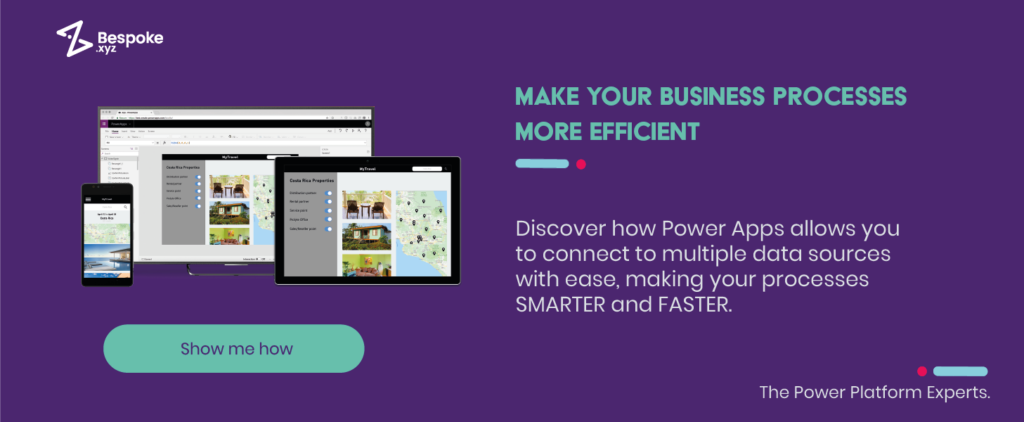Your organisation has taken the plunge and implemented the Power Platform across the board (great, move!). But without proper training, it’s likely that you’re not using it to its full potential. You’ve got this powerful tool at your fingertips, yet things aren’t quite running as smoothly as you’d hoped.
We see this all the time with clients, and we understand the frustration when tech doesn’t quite hit the mark. So let’s get into the top 5 most common mistakes when using the Power Platform technologies:
Power Platform Mistake #1: Lack of Proper Documentation
Imagine you’ve just bought yourself some flatpack furniture from IKEA, only to get it home and there are no instructions. Cue the chaos!
Without proper documentation, you’re left guessing – and that can lead to mistakes and delays. The same holds true for the Power Platform.
Why It’s a Mistake:
- Knowledge Transfer: People come and go in any organisation. Detailed documentation ensures that when a team member leaves, the next person can step in seamlessly.
- Troubleshooting: When things go wrong – and let’s face it, they will at some point – having a detailed troubleshooting guide is invaluable. Instead of wasting time trying to diagnose the issue from scratch, you can quickly refer to your documentation and get back on track.
- Compliance & Audit: Regulatory requirements and audits are part and parcel of modern business. Proper documentation simplifies these processes, ensuring you can quickly provide the necessary information and maintain compliance with ease.
- Holistic Insight: Comprehensive documentation, including workflow diagrams, solution architecture, data models, and user manuals, offers a complete perspective. It helps everyone understand the big picture and how each part fits into the whole.
How to Avoid It:
- Start Early: Begin documenting from the get-go. Don’t wait until the end of the project to start writing things down. Capture details as you go to ensure nothing gets overlooked.
- Be Thorough: Include everything – from high-level overviews to detailed instructions. Your documentation should cover every aspect of your solution, ensuring anyone can pick up where you left off.
- Use Clear, Concise Language: Avoid jargon and overly technical language. Remember, your documentation should be understandable to everyone, not just the tech-savvy members of your team.
- Update Regularly: Documentation isn’t a one-and-done task. As your solution evolves, so should your documentation. Make regular updates to reflect changes, improvements, and new features.
- Leverage Visuals: Diagrams, flowcharts, and screenshots can make your documentation more accessible and easier to understand. Use visuals to complement your written instructions and provide a clearer picture.
- Centralise Your Documentation: Keep all your documentation in a single, easily accessible location. Whether it’s a dedicated documentation tool, a shared drive, or an internal wiki, make sure everyone knows where to find the information they need.
Power Platform Mistake #2. Not Abiding by Coding Standards
No-code and low-code solutions are transforming the way we build software, making it easier and faster than ever before. But even in this simplified environment, ignoring solid coding practices can lead to a world of trouble.
Why It’s a Mistake:
- Maintainability: Code that’s easy to understand and follow makes future updates and maintenance a breeze. Without clear standards, your codebase can quickly become a tangled mess that’s difficult to manage.
- Collaboration: In a team environment, well-documented and standardised code ensures everyone is on the same page. It allows for smoother collaboration and makes it easier for new team members to get up to speed
- Scalability: Adhering to coding standards helps ensure that your solution can scale effectively as your business grows. Poorly written code can become a bottleneck, limiting your ability to expand.
- Debugging: Clean, well-documented code makes identifying and fixing bugs much easier. When your code follows a consistent structure, it’s simpler to track down issues and understand how different parts of your solution interact.
How to Avoid It:
- Embrace Simplicity: Write code for clarity first. Avoid overcomplicating things. Simple, straightforward code is easier to read, understand, and maintain.
- Comment Consciously: Go beyond explaining what the code does – explain why it does it. Comments should provide context and insight, mapping out your thought process for future users.
- Pick Descriptive Names: Use meaningful, descriptive names for variables, functions, and other elements. Good naming conventions act like signposts, guiding users through your code.
- Follow Consistent Formatting: Stick to consistent formatting rules for indentation, spacing, and line breaks. Consistency makes your code more predictable and easier to read.
- Use Version Control: Implement version control systems like Git to track changes, collaborate with others, and manage different versions of your codebase.
- Regular Code Reviews: Conduct regular code reviews to ensure standards are being met. Peer reviews help catch issues early and provide opportunities for learning and improvement.
Power Platform Mistake #3. Not Testing Properly
Skipping proper testing can be tempting when you’re eager to launch a new solution, but it’s a shortcut that can lead to serious headaches down the road.
Why It’s a Mistake:
- Error Detection: Proper testing helps identify and fix bugs before they reach end users. Catching errors early prevents small issues from becoming big problems.
- Usability: By testing your solution with real users, you can uncover usability issues that might not be apparent during development.
- Performance: Testing helps ensure that your solution performs well under different conditions. This includes handling large amounts of data, multiple users, and various use cases.
- Security: Comprehensive testing includes security testing to identify vulnerabilities and ensure your solution is secure against potential threats.
How to Avoid It:
- Detailed Testing Plans: Develop comprehensive testing plans that cover all aspects of your solution. This should include functional testing, performance testing, security testing, and usability testing.
- Test for Every User Type: Ensure your testing covers all potential user types and scenarios. This helps identify issues that might only occur under specific conditions.
- Staged Release: Consider a staged release approach, where the solution is rolled out to a small group of users before full deployment. This allows you to gather feedback and make necessary adjustments before a wider launch.
- User Acceptance Testing (UAT): Involve actual users in the testing process. User acceptance testing ensures the solution meets the needs and expectations of its intended users.
- Continuous Testing: Testing shouldn’t be a one-time event. Implement continuous testing practices to regularly test and validate your solution as it evolves.
Power Platform Mistake #4. Ignoring UI/UX
The Power Platform is a powerhouse of functionality, but all the features in the world won’t help if users can’t easily navigate and use your solution.
Why It’s a Mistake:
- User Adoption: A well-designed UI/UX ensures that users can quickly learn and adopt the new system. If the interface is confusing or unintuitive, users are likely to resist using it, reducing the overall effectiveness of your implementation.
- Efficiency: Good UX design helps users complete tasks more efficiently, saving time and reducing frustration. An intuitive interface streamlines workflows and improves productivity.
- Error Reduction: Clear and intuitive design reduces the likelihood of user errors. When users understand how to interact with the system, they are less likely to make mistakes.
- Accessibility: A thoughtful UI/UX design considers the needs of all users, including those with disabilities.
How to Avoid It:
- User-Centred Design: Focus on the needs and preferences of your end users from the start. Involve them in the design process to gather insights and feedback.
- Simplicity and Consistency: Keep the design simple and consistent. Use familiar design patterns and maintain consistency in layout, colours, and typography to make navigation intuitive.
- Clear Navigation: Design a clear and logical navigation structure. Users should be able to find what they need quickly and easily without getting lost.
- Responsive Design: Ensure your solution works well on various devices and screen sizes. A responsive design adapts to different environments, providing a seamless experience across desktops, tablets, and mobile devices.
- Accessibility: Implement accessibility best practices to ensure your solution is usable by people with disabilities. This includes using proper contrast ratios, providing alternative text for images, and ensuring keyboard navigation.
- Continuous Feedback: Implement mechanisms for continuous user feedback. Regularly update and improve the UI/UX based on user input and evolving needs.
Power Platform Mistake #5. Not Planning for Scalability
Starting with the Power Platform can feel like opening up a treasure chest of tools and possibilities. However, not planning for scalability can lead to significant issues as more users and data are added to the system.
Why It’s a Mistake:
- Performance Issues: As your user base grows, so does the load on your system. Without scalability planning, you might face performance bottlenecks, slowdowns, and crashes, which can frustrate users and disrupt operations.
- Resource Limitations: Solutions that aren’t designed to scale can quickly run into resource limitations, such as insufficient storage, processing power, or bandwidth. This can limit your ability to expand and meet increasing demands.
- Cost Efficiency: Planning for scalability helps you manage resources more efficiently, avoiding unnecessary costs. It allows you to scale up or down based on demand, ensuring you only pay for what you need.
- Future-Proofing: Businesses evolve, and so do their data and user requirements. Scalable solutions ensure that your systems can grow with your business, accommodating new features, integrations, and technologies without needing a complete overhaul.
How to Avoid It:
- Architect for Growth: Design your solution with scalability in mind from the start. Use modular and flexible architectures that can easily accommodate additional users and data.
- Leverage Cloud Services: The Power Platform integrates seamlessly with Microsoft’s cloud services, offering scalable resources on demand. Utilise these services to ensure your solution can handle varying loads without performance issues.
- Monitor and Optimise: Implement monitoring tools to track performance and resource usage. Regularly analyse this data to identify bottlenecks and optimise your solution for better scalability.
- Test for Scale: Conduct scalability testing to simulate different load scenarios. This helps you identify potential issues and make necessary adjustments before they affect your users.
- Plan for Future Needs: Consider future business goals and potential growth when designing your solution. Ensure your architecture can support new features, integrations, and technologies as your business evolves.
The Power Platform is a game-changer, but only if you use it right. Avoiding these common mistakes – poor documentation, skipping coding standards, not testing properly, neglecting UI/UX, and overlooking scalability – can make all the difference in getting the most out of this powerful tool.
We get it, navigating this terrain can be tricky. That’s where we come in. At Bespoke XYZ, we’ve seen it all and we’re here to make sure you sidestep these pitfalls. Our team knows how to make the MS Power Platform work for you – from thorough documentation and rock-solid coding practices to rigorous testing, seamless user experiences, and scalable solutions.
If you’re ready to really harness the power of the Power Platform technologies and take your business to the next level, we’re ready to help. Get in touch today to speak with a Power Platform consultant on our team.


